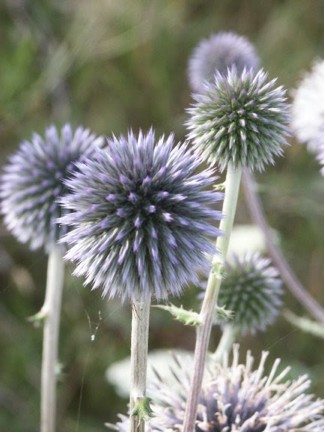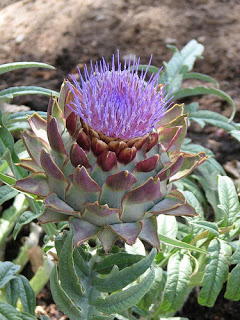What happens when you let an artichoke go to seed?
From its silvery green foliage, a stunning
thistle flower is born.
Its cousin, the Cardoon, is equally striking flower-wise and
makes an excellent gratin too.
In fact, both are edible members of the thistle family, Cynareae.
This large tribe of plants can be beautiful, delicious, healing and downright evil – just like any family, really. Thistles have been around for centuries, symbolically representing nobility in
character and birth.
The unassuming Scots Thistle, Cynareae Onopordum, purportedly saved Scotland in the 1200s when an invading army of Norsemen tried to sneak up on sleeping Scotsmen. Salvation came when the mighty Vikings stepped on the spiky flowers and understandably let out a few loud “faens” and “dritts” (best not to say these words in front of little Norwegian children and old and proper Norwegian ladies.)
Ask a country person what they think about thistles and you might want to cover your ears. Canada Thistle, Cynareae Cirsium, with its spiny leaves and over-enthusiastic roaming, is listed in a majority of countries as an invasive species, though it looks fairly innocent here.
 The Contrary Farmer speaks of it quite eloquently in his piece, “Famous Weeds I Wish I Had Not Met”
The Contrary Farmer speaks of it quite eloquently in his piece, “Famous Weeds I Wish I Had Not Met”
Heed his warning and do NOT plant this in your garden.
More useful would be the Milk Thistle, Cynareae Silybum Adans. If you happen to ingest a Death Cap mushroom, you can increase your chances of survival substantially by following up with a dose of the active ingredient silymarin in this thistle which studies suggest prevents and repairs damage to the liver from toxic chemicals and medications.
Simple mnemonic device: Eat poison mushroom = Silly Bum
Milk thistle is also supposed to be good for protecting the liver from an excess of alcohol, good news for those with a lush disposition.
And finally, I love the Globe Thistle, Cynareae Echinops. You might notice it in a certain logo…
 It’s hard to decide if these bristly balls are more Jurassic or post-apocalyptic, but either way, I find their surreal quality utterly appealing.
It’s hard to decide if these bristly balls are more Jurassic or post-apocalyptic, but either way, I find their surreal quality utterly appealing.
A grouping of these sublimely colored plants makes an effective focal point. If you have a bold streak, go Triffid-y and plant the Brobdingnagian artichokes and cardoons.
And you might have something to eat in an apocalypse.
by Nancy Knapp
Weeds Garden & Interior Design


